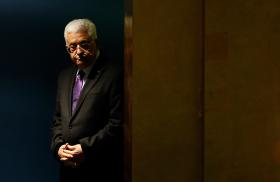
- Policy Analysis
- PolicyWatch 3085
The Hodeida Redeployment Plan: A Slow Start in Yemen

Even as it nudges the parties to make good on their initial withdrawal agreements, Washington should counsel patience on what will likely be a long, bumpy road toward full peace talks.
Nearly two months after signing the Stockholm Agreement, the internationally recognized government of Yemen and the Houthi rebel group agreed to terms for implementing a narrow but critical part of that accord: the “redeployment” of their forces in certain parts of Hodeida province. The terms were agreed after talks on February 16-17 led by Lt. Gen. Michael Lollesgaard, the newly appointed head of the UN Mission in Support of the Hodeida Agreement and chair of the Redeployment Coordination Committee. Although these steps represent only a piece of an already-narrow agreement, the UN is cautiously hopeful that they will be the first in a series of confidence-building measures ultimately leading to full peace talks.
SLOW START
Signed on December 13, the Stockholm Agreement focused on three issues: (1) redeploying forces in Hodeida, (2) creating a mechanism for prisoner exchanges, and (3) beginning discussions on implementing a ceasefire and opening humanitarian corridors in Taizz province. Despite its limited focus, the document was significant because it was the first agreement between the parties in two-and-a-half years. At the same time, its deliberately vague language bred little confidence that the parties had actually agreed to anything of substance. Nevertheless, the UN framed it as a positive statement of intent and indicated the parties would continue discussing its three areas of focus via committees.
As the weeks passed and the parties met, the UN continued its hopeful narrative that the Hodeida ceasefire was holding and talks were progressing. Yet media outlets on all sides were painting a different picture. Houthi spokesman Mohammed Abdulsalam blamed the government for evading its obligations. Meanwhile, the Saudi-led coalition fighting on the government’s side released data on Houthi ceasefire violations—numbering 1,400 by February 14—and suggested that the rebels were “intentionally hindering the implementation to gain time to build their military capabilities.”
As a result, talks have been fraught, deadlines have repeatedly passed with no agreement, and even finding secure meeting locations acceptable to both parties has been difficult. On one occasion, after the Houthis refused to cross into government-controlled territory for a meeting, the UN creatively found neutral territory: a boat. Such examples underscore the severe lack of trust between the parties, though UN special envoy Martin Griffiths insists that both Yemeni parties have the “political will” to reach agreements.
WHAT THEY AGREED TO
Despite the delays, the parties managed to come to a narrow agreement on what the UN is calling “Phase 1” of the Hodeida withdrawal. This latest agreement does not cover the second phase of the withdrawal, prisoner exchange mechanisms, or Taizz.
In a recent interview on Al-Arabiya, Griffiths explained the two steps involved in Phase 1. First, the Houthis will redeploy from the ports of al-Salif and Ras Issa, which are north of Hodeida port, and remove the large number of landmines they have laid. Second, the Houthis will redeploy from Hodeida port itself, and both parties will move to agreed locations north and south to facilitate access to Red Sea Mills and other critical sites. Red Sea Mills is the World Food Programme’s main distribution facility for wheat and flour; according to Griffiths, it has enough storage to provide subsistence provisions for 3.7 million Yemenis for a month. This week, as part of the latest agreement, UN personnel were able to access the site for the first time since September, amid concerns that its wheat stocks might rot.
Under Phase 2, the terms of which have yet to be agreed, another set of redeployments will take place. Griffiths has indicated they will lead to the “demilitarization” of Hodeida city and allow for a humanitarian corridor.
Several issues remain unresolved. First, no one has specified the “local forces” that are supposed to assume responsibility for security in Hodeida port and city as the parties withdraw. The government worries that that Houthis will leave behind “local” personnel that are secretly loyal to them, as they have done in the past.
Second, the exact timing of the redeployments remains unclear. Initial reports suggested they should begin early this week. Access to Red Sea Mills is a start, but the port withdrawals appear delayed. Predictably, both sides are blaming each other. Some of the holdup may be logistical; for example, it is unclear how quickly the Houthis can clear the heavily mined al-Salif peninsula even if they put forth maximal effort toward that end. Other delays may be more political.
Whenever implementation finally occurs, the UN will be in charge of verifying compliance. If the Houthis do not comply in a reasonable amount of time, the patience of the Yemeni government, its coalition backers, and conceivably other international actors will wear thin, and the already fragile UN process may need U.S. intercession to ensure it survives. Toward that end, Washington should urge the coalition to remain patient and avoid publicly lambasting the UN process or undertaking further military campaigns.
WHAT’S NEXT?
If the UN deems Phase 1 of the Hodeida agreement a success, then negotiating Phase 2 will become the priority. If implementation fails, however, Phase 1 talks will reconvene with further erosion of trust.
Griffiths and his team are simultaneously focused on the two other major aspects of the Stockholm Agreement: prisoner releases and a Taizz humanitarian corridor. On the former, the Supervisory Committee on the Implementation of the Prisoner Exchange Agreement—made up of Houthi and Yemeni government representatives with participation by the International Committee of the Red Cross—has met several times in Amman, Jordan. The plan is to release prisoners in batches, with a large first batch to breed confidence in the process. Separately, the parties may conduct humanitarian releases, as occurred a few weeks ago when the Houthis freed an ill Saudi prisoner and Riyadh released seven Houthis in return.
Progress on the Taizz corridor has been slower. Since Stockholm, the parties have nominated members for a committee on the issue, but Griffiths stated that it has not met because the parties have not determined a safe location to do so. Once the committee convenes, its main goals will be opening humanitarian corridors through Taizz city (which has been under a crippling siege for much of the war) and implementing a local ceasefire. Such arrangements would also allow the key road between Sana and Aden to be used more freely, including by humanitarian agencies.
In the meantime, the UN convened its third High-Level Pledging Event for the Humanitarian Crisis in Yemen this week in Geneva. The organization asked for $4.2 billion—its largest appeal ever—for the 24 million people suffering there, and initial reports suggest it raised at least $2.6 billion. Yet money is only part of what is needed. Humanitarian corridors, port access, safe passage on key roads, and significant demining efforts are necessary to actually get aid to the people who need it, and each of these measures hinges on the parties reaching and implementing agreements regarding Hodeida and Taizz.
More broadly, all of the players need to keep in mind that the narrowly focused Stockholm process is only the opening act to full peace negotiations. Griffiths has purposefully referred to any discussions between the parties as “consultations” rather than “peace talks,” likely hoping that these confidence-building measures will enable the parties to address the war itself in a future round of discussions. When asked by Al-Arabiya if he believes another set of major talks can convene by this summer, he responded enthusiastically, implying that they may be possible even sooner.
The United States should back the special envoy’s efforts, but with a dash of caution. If the latest Hodeida agreement is implemented satisfactorily, progress toward wider talks should of course accelerate. Yet if the fraught efforts thus far are any indicator, genuine peace talks are still a long way off. What is needed above all from the United States, Britain, and other like-minded international partners is political will, unrelenting engagement, and an emphasis on patience, including within the Saudi-led coalition. These ingredients are crucial to sustaining what will inevitably be a slow, uncertain, and difficult process to end this complex conflict.
Elana DeLozier is a research fellow in The Washington Institute’s Bernstein Program on Gulf and Energy Policy.



